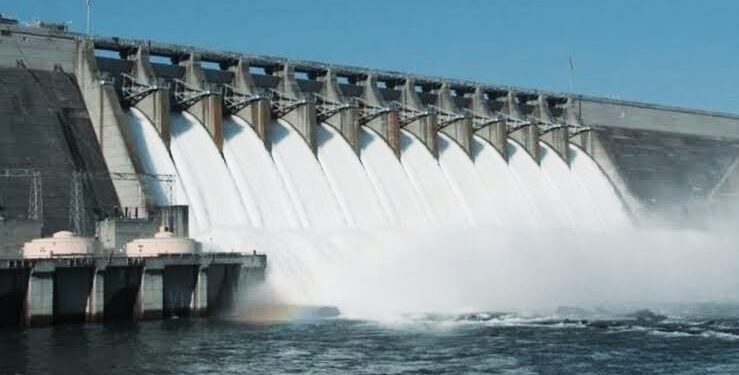Tracts of land and communities downstream of the Akosombo and Kpong dams have been flooded.
This follows the second-stage spillage of the two dams used to generate about a third of the country’s electricity supply.
The Volta River Authority (VRA) started the controlled spillage at the Akosombo and Kpong dams, both in the Eastern Region, in September.
15 this year following excess water in both reservoirs due to appreciable levels of rainfall.
The spillage has affected almost all the communities along the lower Volta Basin, resulting in widespread power cuts in the affected communities.
The GRIDCo sub-station in Fievie, Sogakope, in the Volta Region, has been inundated with floods, leading to the shutting down of the station.
With the absence of electricity, public installations, including hospitals in Sogakope and Adidome, are bearing the brunt of the flooding, leaving the lives of patients in danger.
High water levels
The maximum level of water in the Akosombo Dam should be 276 feet.
As of Thursday (Oct. 12), the water level in the dam was 276.92 feet, or 84.405 meters.
Before the spillage, the level was 272.50 feet, or 83.058 meters.
At a press conference at the Akosombo Generation Station yesterday, the Deputy Chief of VRA in charge of Engineering and Operations, Edward Obeng Kenzo, explained that the spillage was necessitated by high inflows into the Akosombo reservoir, resulting in the water level exceeding its upper level.
He said the spillage was to prevent the water from overtopping and compromising the integrity of the dam.
This is not the first time VRA has spilled water from the Akosombo Dam. The last was in 2010, having spilled water from the dam in 1966, 1967, 1968, 1969, 1970, 1971, 1972, 1974, and 1991.
The spillage began at a low rate for about one and a half weeks with no impact on downstream communities.
“However, the inflow into the reservoir continues to increase at a higher rate; therefore, there was the need to increase the spill rate in order to slow down the rate at which the reservoir elevation was rising. This has resulted in the flooding of some communities downstream of the dams,” Mr. Kenzo said.
He said before the spill rate was increased, the authority, in collaboration with NADMO, evacuated some of the residents of the affected communities to higher grounds, the designated safe havens for the communities.
Mr. Kenzo said VRA would continue to monitor the inflows into the Akosombo reservoir “and make a decision to close the spillway gates to stop the spillage when the situation suggests so”.
A Deputy Minister of Energy, Herbert Krapa, while commending VRA for the decisive initiative to spill excess water to save the dams, stressed the importance of the authority to provide relief items for the victims.
He also expressed the hope that when the situation normalised, VRA would plan for the resettlement of the victims.
Also present at the press conference were the Chief Executive of VRA, Emmanuel Antwi-Darkwa, and other directors of VRA.
Cut off
The floods have affected access to communities as roads have been cut off, leaving commuters stranded, with others resorting to the use of boats and canoes, which further endanger their lives.
The most affected communities are in the Asuogyaman District in the Eastern Region, where the Akosombo Dam is located, and in the North, Central, and South Tongu districts in the Volta Region.
Some residents of the South Tongu District capital, Sogakope, fear for the integrity of the Lower Volta Bridge, which spans the Volta River at Sogakope, due to the floodwaters that are less than five meters from the deck (the tarred portion) of the bridge.
Prior to the spillage, canoes could cross under the bridge, but that is no longer the case as the waters have risen above the piles or piers, which can literally be referred to as the legs of the bridge.
Many houses have been swallowed by the raging floodwaters, with families relocating to put up with friends in other towns.
The floods have also claimed large parts of Tefle, Wume, Sokpoe, and other communities along the river, while other settlements, including Alikekope, Agorme, and Agbave, have been wiped off, leaving at least 500 people homeless.
Notable hospitality facilities affected by the floods include Villa Cisneros, the Sogakope Beach Resort and Spa, and the Holy Trinity Spa and Health Farm.
Nurses quarters evacuated
At least 25 nurses were evacuated from the nurses’ quarters at the Comboni District Hospital in Sogakope on Thursday.
A hotel under construction at the bank of the river, a drinking spot, and a piggery, all at Sokpoe near the bridge at Sogakope, have also been severely affected as the water entered the hotel and the drinking spot and destroyed the piggery of 50 pigs.
The volume of water spilled from the dams has also caused some lagoons in the Keta basin to overflow their banks, leading to flooding in many communities in the Anlo and Keta districts.
Some districts are also arranging temporary shelters for people affected by the flooding from the spillage, the last of which was seen in the 1960s.
Some of the worst-affected communities, which the VRA visited in the company of the Daily Graphic and other media houses last Wednesday, include Mafi Dugame, Kebegodo, Atsemkope, Akpokope, Devime, Avadiwoekome, Siamekope, and Bekpo, all in the Central Tongu District in the Volta Region.
The VRA, which presented some relief items to people affected by the floods, said since the start of the exercise, it had positioned officers in communities to always monitor and assess the situation for remedy.
It said the National Disaster Management Organisation (NADMO) was also assessing the damage for the necessary intervention.
Presentation
VRA presented clothes, mattresses, blankets, toiletries, and food items, among other relief items, to NADMO officials for onward distribution to the victims of the flooding.
A Deputy Chief Executive of VRA for Services, Kenneth Arthur, presented the items to the Director-General of NADMO, Eric Nana Agyeman Prempeh, at Adidome, the Central Tongu District capital, last Wednesday.
He said the authority decided to provide the essential relief items in keeping with the VRA’s commitment to alleviate the plight of the communities.
Mr. Arthur said the items were to mitigate the difficulties and challenges being faced by the communities that had been adversely impacted as a result of the intensified spill rate.
He said the authority, in line with the emergency preparedness plan and standard operating procedures, notified its stakeholders, including the downstream communities, before the spillage began in order to prepare themselves for any eventuality.
“The authority wishes to reiterate that its aim is to save the integrity of the dams when the water needed is too much. The authority will continue to work with NADMO and other stakeholders to monitor the situation and provide regular updates to the general public accordingly,” Mr. Arthur assured.
Cooperation
The Director-General of NADMO, Nana Prempeh, thanked VRA for their support for the affected people.
He appealed to all the affected communities where NADMO was carrying out evacuations to cooperate so that all lives could be saved.
Nana Prempeh explained that the spillage, which had just started, would continue as VRA had no choice but to spill the excess water to protect the dams.
Sensitisation
The NADMO boss said his outfit would continue with the sensitisation in the communities along the Lower Volta Basin and among the general public.
The Chief Executive of the Central Tongu District, Thomas Moore Zonyrah, asked all the affected communities to remain calm, saying the assembly would reach out to them individually and collectively.
He said a 400-capacity accommodation block had been secured for the most affected victims at Siamekope and Avadiwoekome to ensure that they were housed, while the assembly looked at alternative arrangements.
Source: Graphic Ghana















